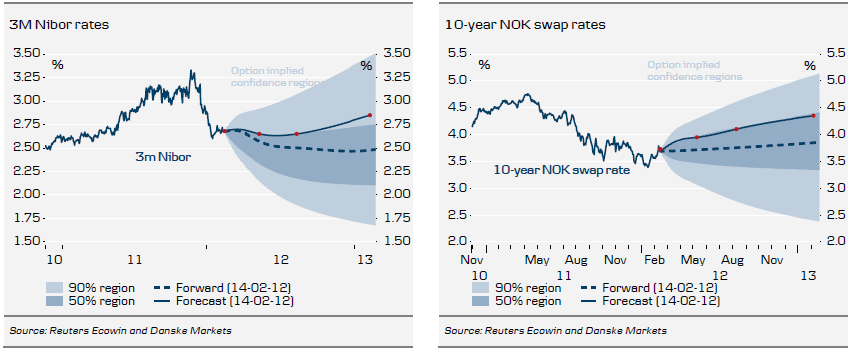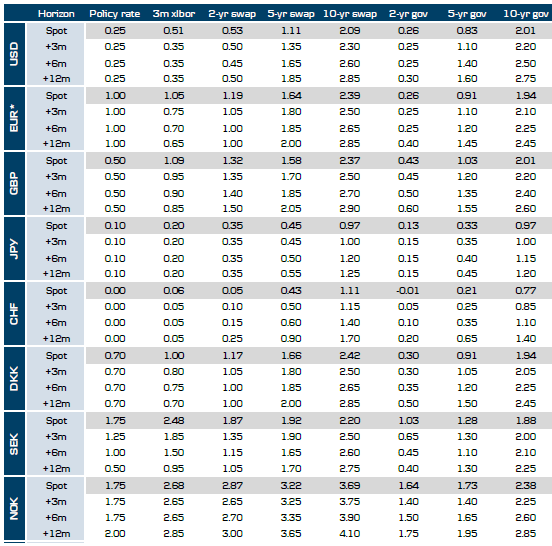Eurozone forecastGrowth and inflation
The economic data are consistent with the eurozone being in a recession in Q4 11 and going into 2012. However, there are tentative signs of stabilisation in activity, albeit at low levels. We forecast that GDP has fallen 0.3% q/q in Q4. Fiscal policy is being tightened, implying that the peripherals are set for negative GDP growth and the core is suffering. We expect the recession to be short and that the euro area will return to positive growth rates in Q2. Due to the headwinds from fiscal tightening and turmoil in the financial markets, we expect the euro area economies to grow only 0.3% in 2012. Inflation should be above the 2% target over the next months before edging below 2%.
Monetary policy and money markets
In February, the ECB kept the leading interest rate unchanged at 1% as expected. No rate cut was discussed. We expect the ECB to keep rates on hold until 2014 – as the economy slowly recovers. The ECB may deliver further rate cuts and more non-standard measures if downside risks materialise. The 3Y liquidity tender carried out in December, and to be repeated on 29 February, has brought significant relief in financial markets. Euribor fixings are declining at a decent pace, something we expect to continue over the next few months, which is putting downside pressure on rates up to 2Y. Our forecasts are slightly
below forwards in the short end of the curve across forecast horizons.
Yield curve
We believe that 10Y US rates have troughed now and we see increased upside risks to long-dated US rates. In combination with easing stress in European markets, we think that longer dated EUR swap rates have also bottomed out. However, we see limited upside for EUR rates over the next three months due to the uncertainties prevailing. We thus expect 10Y EUR rates to be range bound for the next few months, before edging higher on 6M and 12M horizons. We have lifted our forecast slightly. On a 3M horizon our forecasts are in line with forward markets, while they are above forwards on 6M and 12M horizons.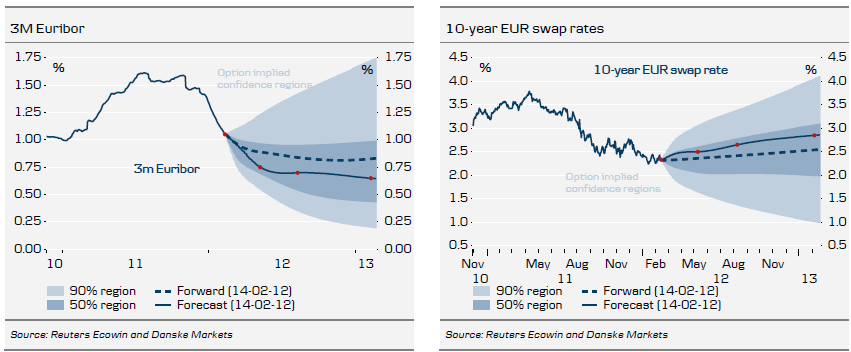
US forecast
Growth and inflationGrowth in the US has recovered from the weakness in H1 and rose to 2.8% in Q4. The labour market has also improved, with US non-farm payrolls averaging 201,000 over the past three months. Private consumption has recovered following a soft patch in H1 and there are tentative signs of improvement in housing. Looking forward, we expect GDP to grow moderately by around 2.5% in 2012. ISM manufacturing has risen gradually and we expect it to continue to rise towards 55 over the coming months. Inflation pressures have eased somewhat recently, as commodity prices have declined. Pricing power is poor and wage increases very muted. We expect core inflation to peak just above 2% in coming months and decline towards 1.5% in 2012.
Monetary policy and the money market
We expect the Fed to remain on the sidelines for now, as the economy is recovering. That said, the central bank maintains an easing bias, should growth slow again. We do not expect further easing in 2012, but it is still possible if the fragile recovery faces new headwinds. The money market is pricing no Fed hikes before H2 2014, which is consistent with the new rate projections published by the Fed. There are signs of relief in the USD funding markets and USD Libor fixings are moving lower. We expect stable to lower USD fixings during the coming months.
Yield curve
The US yield curve remains caught between improving US macroeconomic indicators and the ongoing debt crisis in Europe. However, with signs of easing stress in the financial markets, declining short-end funding rates for European sovereigns and continued healthy macro data out of the US, we believe that 10-year swap rates have troughed. We expect long rates to move higher and forecast a steeper curve. In our view, the risk of a sell-off is increasing. We have made very few adjustments to our forecasts. Our forecast for tenors longer than five years is above the forward market, with the biggest difference
on a 12-month horizon.
UK forecast
Growth and inflationThe UK economy shrank by 0.2% in Q4 11 according to the first estimate from the Office for National Statistics. A mild technical recession cannot be excluded but recent economic data has been encouraging, with forward-looking indicators in particular suggesting economic expansion. Our main assumption is that the UK will avoid recession but it will be a close call. Output remains below pre-crisis levels and real recovery is still something that belongs to H2 12. Private consumption is picking up and we expect consumer sentiment to improve when affordability returns as inflation comes down. CPI has peaked and is now rapidly falling towards the Bank of England‟s 2% target.
Monetary policy and the money market
The Bank of England (BoE) announced in February that it will continue with its
quantitative easing programme. Specifically, the BoE will purchase GBP50bn gilts over the next three months, for a total of GBP325bn. Monthly buying will decrease slightly from GBP18.7bn to GBP16.7bn. As the bond supply in H1 is slightly higher than in Q4, there will be a modest reduction in the net impact of QE. QE will still outpace supply though and should therefore be seen as an effective loosening of monetary policy. We expect the BoE to lift the asset purchase target again in May, also by GBP50bn. Our QE year-end forecast remains at GBP400bn.
Yield curve
The BoE‟s purchase strategy has changed and boundaries between maturity sectors been adjusted. Future gilt operations will be in 3-7 years (Mondays), 7-15 years (Tuesdays) and 15+ years (Wednesdays) – previously 3-10, 10-25 and 25+. The bank intends to purchase evenly across the three gilt maturity sectors. According to the DMO, this operational change is intended to help reduce the risk of undesirable frictions in the functioning of the gilt market arising from the concentration of the bank‟s holdings of gilts in certain maturity sectors. It means in other words that shorter-dated bonds will be more supported by QE going forward while longer-dated bonds will have less support, i.e. the yield curve should be steeper – a „reverse operation twist‟. We believe the yield on the 10Y note will remain low, in a 1.95-2.25% range.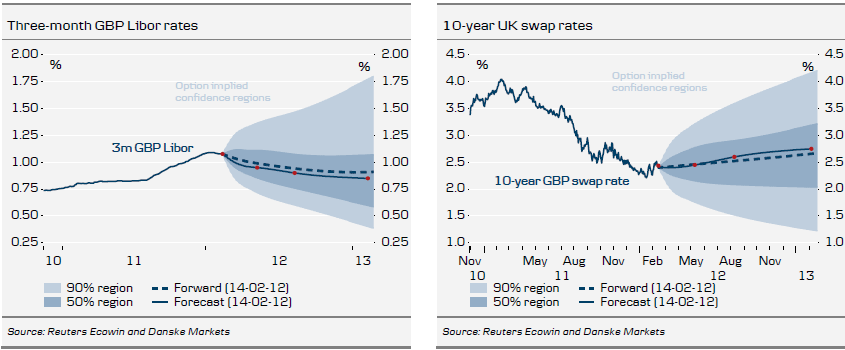
Denmark forecast
Growth and inflationMonthly growth indicators continue to look better than expected. Exports are performing well, despite the downturn in major export markets in the euro area and Sweden. Private consumption is also slowly crawling out of last year‟s slump. Thus, we believe the Danish economy returned to a growth path in Q4 and recession fears have thus diminished. For 2012 and 2013, we forecast GDP growth of around 1%. Inflation picked up in January rising to 2.8% y/y from 2.5% y/y in December. The increase was due to higher regulated prices and higher gasoline (petrol) prices. Furthermore, the Danish budget deficit for 2011 looks set to comply with the EU criteria of 3% of GDP despite clear expectations of the opposite. Higher revenue from tax on pension returns has cut the deficit to around 2.5%.
Monetary policy and money markets
Although general risk sentiment has improved over the past month, EUR/DKK continues to trade close to the level that triggered intervention and rate cuts in December. Hence, if the currency inflow into Denmark intensifies the pressure for a new independent Danish rate cut could easily return. However, given our somewhat positive view on risk, we continue to expect the repo rate to remain unchanged at 0.70% throughout 2012. The risk of a new rate cut and even a negative CD rate cannot be ruled out not least if the ECB lowers its key rates. Note that in this respect the possibility of negative rates is now mentioned under Monetary Policy Instruments at Nationalbanken.dk. The Cibor fixings have declined only marginally over the past month and the negative fixing spread to the eurozone is thus closing with the continued decline in Euribor fixings. Going forward, we expect Cibor fixings to resume their downtrend but we expect the positive spread to Euribor to be reinstated.
Yield curve
Danish bonds have continued to underperform German bonds over the past month and the negative swap spread between Denmark and Germany has disappeared. There are several reasons for this. First, the improvement in risk sentiment has reduced safe-haven flows into Danish markets. Second, the issuance of 30Y callables has increased hedging interests, which pushed up Danish rates. Finally, the change in the discount curve for the Danish L&P sector has had an effect. We expect Danish rates to trade relatively close to German rates ahead. Our forecasts are in line with forward markets on a 3M and 6M horizon, while they are above forwards on 12M horizon.
Sweden forecast
Growth and inflationRecent data suggest that the Swedish economy slowed sharply late last year. Production, trade balance, retail sales, PMI and confidence surveys all suggest that fourth quarter GDP is likely to have dropped by more than 1% q/q and this will feed into a decline for GDP for the full 2012. Needless to say, there is a risk of a significant rise in unemployment in 2012. On the back of this, we believe the stage is set for a continued decline in headline and core inflation, both may be close to zero by the end of the year.
Monetary policy and the money market
In our view Riksbank cannot disregard the worse-than-expected outcome in Q4 and it has to revise down its GDP and inflation forecasts and, in addition, cut the repo rate on 16 February. We also take some comfort in the fact that Riksbank has assumed that the European debt crisis will be resolved, which simply has not happened. Moreover, Fed, World Bank and IMF - institutions that Riksbank tends to put some trust in - have all revised down their economic forecasts.
Yield curve
Based on the fact that repo rate cuts equal to only some 60bp are discounted by the market over the next couple of meetings we think that the bond curve will steepen during the course of next year. A combination of lower short rates and, eventually, somewhat higher long-dated rates will render the bond curve steeper. A low inflation rate and Riksbank cuts suggest lower rates at the front end. At the long end of the bond curve the rates are at an all-time-low and the Debt Office will launch a new 20y bond in the spring, which might cool longer yields a bit ahead of the issuance of the bond.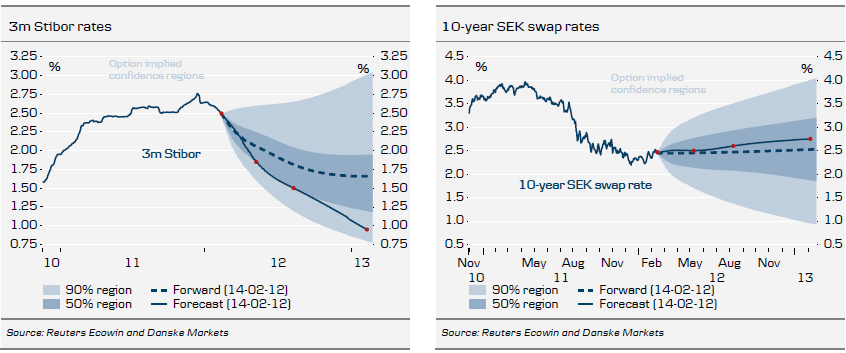
Norway forecast
Growth and inflationAs the oil price is holding up, oil investments and solid growth in national income counteract the negative effect on the export sector from the European debt crisis. Hence, the capacity utilisation is close to normal and growth is expected to be above trend in 2012. The latest key figures support this view. The recoil in the PMI in January reduces the downside risk stemming from subdued global growth and rising house prices underscore the fact that real interest rates are too low to be sustainable even though growth in private consumption is moderate. In addition, the surprising drop in unemployment in January
illustrates that growth is above trend and that the probability of a drop in wage growth is diminishing. Core inflation is still moderate, but downside risks seem limited as cost inflation remains in place and consumption growth hovers around 3%.
Monetary policy and the money market
As downside risks are diminishing and the housing market and household debt continue to expand, we still expect Norges Bank to leave policy rates unchanged until the first rate hike will be delivered in December. As a result of the current improvement in economic data, the market has gradually started to re-price the expectations of further cuts. However, our forecast is still 25-75bp higher than the current market pricing on a 1-3 year horizon.
Yield curve
We expect the Norwegian 2-10 swap curve to steepen over the course of 2012, but not as much as global curves. Unlike most other markets, we expect the short end to move upwards as further cut expectations gradually fade out. Of course, we expect the long end of the curve to have bottomed in line with European and US longer dated rates.